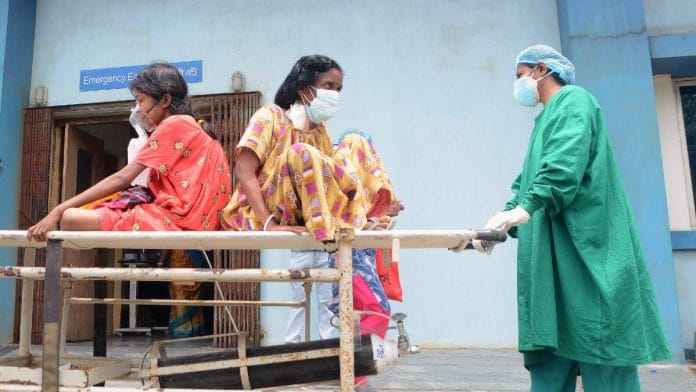Kolkata: West Bengal’s effective reproduction rate for Covid-19 — a measure of how fast the infection is spreading within the population — witnessed a sharp rise in the past week and government officials have blamed the Delta variant or B.1.617.2 for this.
On 8 June, Bengal’s R value was 0.4, which reached 1.36 Thursday.
According to a top official of the state’s health department, the Delta variant, which was first identified in Maharashtra, was found in nearly 90 per cent of the cases registered in the past fortnight.
“The state has witnessed an infectious strain that spreads to four persons from one affected person, and this took the state’s R to 1.36,” the official, who wished to remain unnamed, told ThePrint.
At 1.36, West Bengal’s R value is much higher than the national R, which dropped to 0.78 in the last two weeks. India’s R is the lowest it has been since the pandemic hit the country last year.
According to Professor Soumitra Das, director of the National Institute of Biomedical Genomics (Kalyani), B.1.617.2 is the predominant variant in the state.
“B.1.617.2 has outplayed all other strains. In Bengal, this is the predominant variant. Double mutant strain is an important factor that contributed to the rise of R value,” he told ThePrint.
“Apart from that, the Covid appropriate behaviour is also an important factor. In fact, the month-long lockdown brought the infections down. But the strain is still there and people should not put their guard down.”
Meanwhile, Professor Partha Majumdar, also from NIBMG, agreed with government data and said: “The Delta variant is highly infectious. It is true that around 90 per cent of total samples are showing the double mutant strain B.1.617.2 variant. Once the strain enters, it infects fast.
ThePrint reached West Bengal’s Health Secretary N.S. Nigam for a comment via calls and text messages but no response was received till the time of publishing.
According to the World Health Organization, B.1.617.2 has a substantially higher growth rate than other circulating variants in India, suggesting potential increased transmissibility. It was classified as a ‘variant of concern’ by the WHO on 10 May.
West Bengal’s health department also claimed that the state’s present R was calculated on old data, when the caseload was much higher last week. A senior health department official noted that with cases decreasing every day, the R must have also gone down now.
In the first week of June, the state was registering over 7,000 cases daily, which fell sharply to about 4,450 daily cases in the second week.
The Mamata Banerjee-led government has also extended restrictions till 30 June. However, some relaxations have been implemented, including limited operations of market places, malls, restaurants, and government and private offices.
Also read: Flagged new strain in Feb to central govt, NIV but no action was taken: Maharashtra Covid adviser
Delta variant on the prowl in West Bengal
According to a senior scientist associated with the government, as many as 90 per cent of the Covid samples that were sequenced last week showed the presence of the Delta variant.
“Our R value was high last month and it touched around 2, but then it again fell below 1. Around 30 to 40 per cent samples were then detected with the Maharastra double mutant strain. But it shot up last week again, with around 90 per cent of the samples showing double mutant strain. Cases of full families getting infected from one person were reported to us,” the scientist, who wished to remain unnamed, told ThePrint.
“Reading R value is a dynamic thing and it keeps changing. This week, our cases are falling daily, which means R value will also fall eventually,” he added.
Professor Majumdar, who is also the national science chair of Government of India, noted that the “R value may change”, however, “the Delta variant will take over now. Soon we will get all samples showing this double mutant strain”.
According to government officials, the situation is being monitored closely and the travel restrictions in the state will not be lifted till the variant is brought under control. A mandatory negative RT-PCR certificate is required to enter the state, at present.
Ajoy Chakraborty, the state’s director of health services, said, “We have been able to control the infection rate. We are opening up in a phased manner considering all factors. Every factor is being monitored closely by experts.”
The state’s positivity rate — percentage of people who are found to be infected by the virus from those who are being tested — has fallen to 6 per cent in June from a steep 30 per cent in April, after a 45-day lockdown.
According to government data, on 16 June, the state vaccinated around 1,16,772 people. And till now, a total of 1,82,46,371 people have been vaccinated, which is around 20 per cent of the total population.
In the 18-44 age group, a cumulative 19,96,535 people have been vaccinated since the drive began last month, noted the West Bengal health department’s official data.
Also read: Doctor operates on MP woman to remove tumour from brain. It turns out to be white fungus






